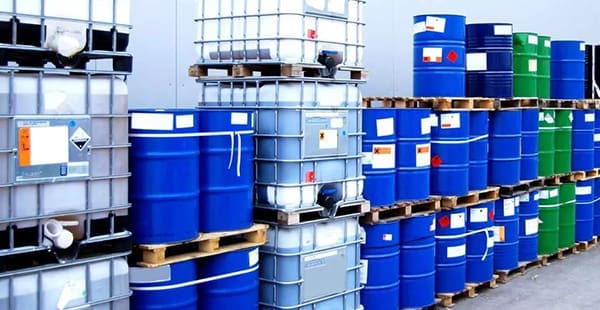How Was Asbestos Used at Chemical Plants?
Many chemical companies added asbestos to their building materials, machinery and products. For example, asbestos could be found in cement, pipe insulation and boilers. Asbestos resists chemicals and high temperatures, making it a preferred choice in these applications.
Ironically, asbestos was used in these hazardous environments to increase worker safety. The heat-resistant mineral was used to make equipment safer. It also reinforced protective gear worn by employees. However, the fibers could become easily disturbed during installation, repair and maintenance. Airborne asbestos fibers pose an asbestos exposure risk to nearby individuals.
If a worker inhaled or ingested these fibers, they may be at risk of developing an asbestos illness later in life. Asbestos-related diseases, such as mesothelioma, can develop up to 50 years after initial exposure.
Asbestos use in the United States decreased drastically by the 1980s. However, chemical plants may still have older asbestos-containing products. Chemical plant workers may be at risk if old asbestos materials are disturbed.
Notable Chemical Plants That Used Asbestos
Chemical plants across the country used asbestos in a variety of ways. Many U.S. chemical plants are still removing asbestos from their facilities.
This asbestos use exposed many workers and their loved ones. As a result, companies continue to face asbestos lawsuits and mesothelioma claims.
Hercules Chemical Company
Hercules Chemical Company manufactured a variety of products for the plumbing industry. Beginning in the 1950s, the company used asbestos in some of its cement and putty products.
As a result of the company’s asbestos use, employees and consumers experienced asbestos exposure. Hercules Chemical has faced lawsuits because of its use of asbestos and Agent Orange.
By 2008, the company faced roughly 7,000 asbestos lawsuits. To resolve the lawsuits, Hercules Chemical filed for Chapter 11 bankruptcy.
Hercules Chemical later established an asbestos trust fund in 2010. The company still accepts and pays successful asbestos trust fund claims.
Dow Chemical Company
Dow Chemical Company is one of the three largest chemical producers in the world. For many years, the company used asbestos-containing materials at its facilities.
The company’s use of asbestos products, such as asbestos insulation, exposed many workers to the mineral. Dow Chemical has faced thousands of asbestos lawsuits from individuals who said the company was negligent.
Despite knowing the health risks associated with asbestos, Dow Chemical continued to lobby the Environmental Protection Agency (EPA) to use the mineral. Dow Chemical has also continued to oppose banning asbestos in countries around the world.
TPC Group
TPC Group used asbestos during the construction of its plant in Port Neches, Texas, in the 1940s. TPC Group, formerly known as Texas Petrochemicals, used asbestos materials like pipe coverings and block insulation. Workers in this plant may have been exposed to asbestos during construction and renovation.
In November 2019, a butadiene leak occurred, causing a vapor cloud to form and ignite. Several explosions sent debris into the air, including an entire tower of the plant. Jefferson County officials instituted a four-mile evacuation zone.
The explosion released asbestos fibers into the environment. County leaders warned residents of nearby Beaumont, Nederland and Port Arthur about the asbestos danger. Officials believe up to 50,000 residents in the Beaumont and Port Arthur areas may have been affected.
Other Chemical Plants That Caused Exposure
Chemical plants that have had documented incidents of asbestos exposure across the United States include:
Alabama
- Allied Chemical Corporation
- Calabama Chemical Company
- Ciba-Geigy Chemical Company
- Diamond Shamrock Chemicals
- Kerr-McGee Chemical Corporation
- Olin Mathieson Chemical Corporation
- Stauffer Chemical Company
California
- Allied Chemical Corporation
- USS-POSCO
Connecticut
- Naugatuck Chemical Company
- Uniroyal Holding Inc.
Delaware
- Hercules Powder Company
Florida
- PetroChemical Products
- Stauffer Chemical Company
Iowa
- Irwin Chemical Company
- USI Chemical Co.
Kansas
- Harcros Chemical Company
Louisiana
- Baton Rouge Exxon Refinery
- CONDEA Vista Chemical
- Dow Chemical Company
- Olin Corporation
- Thompson-Hayward Chemical Company
Maine
- Union Chemical Company
Maryland
Michigan
- Dow Chemical Company
Missouri
- Monsanto
- Thompson-Hayward Chemical Company
New Jersey
- Allied Signal Inc.
- American Cyanamid Company
- Hercules Chemical Company
- Industrial Liquid Chemical Company
New Mexico
- Roswell Industrial Air Center
New York
- DuPont Yerkes Plant
- Durez Plastics and Chemicals Inc.
- Hooker Chemical
Ohio
- Borden Chemical Company
Oregon
- Borden Chemical Company
- Chevron Chemical Fertilizer Plant
- Chipman Chemical
- Georgia-Pacific Corporation Resin Plant
- Pennwalt Sodium Chlorate Plant
- Portland Gas and Coke Company
- Rhone-Poulenc Chemical Plant
- Stauffer Chemical Company
Rhode Island
- Dytex Chemical Company
Tennessee
- Chapman Chemical Company
Texas
- Chevron Phillips Pasadena Plastics Complex
- Houston Refining LP
- LyondellBasell Plant
- TPC Group Chemical Plant
- Union Carbide Corporation
Washington
- Shell Oil Refinery
- Texaco Oil Refinery
Wyoming
- Allied Chemical Corporation
- Standard Oil Refinery
- Stauffer Chemical Company
- Texaco Oil Refinery
Who Is at Risk of Exposure at Chemical Plants?
Chemical plant workers who came into contact with asbestos on the job risked occupational exposure. A variety of workers frequently came into contact with asbestos insulation, cement and other products.
Asbestos was added to chemical plant machinery and products because of its heat and chemical resistance. While handling these products, asbestos fibers could become airborne. Fibers may then be inhaled or ingested and become embedded in organ tissues.
Airborne asbestos at chemical plants put workers at risk of developing asbestos-related conditions. Potential related illnesses include mesothelioma, asbestosis and lung cancer, among others.
In the late 1980s, researchers studied 995 petrochemical employees. Almost 10% of workers had an asbestos-related abnormality that showed up on an X-ray. According to the study, maintenance personnel, painters, utility workers and auditors had the highest rates of asbestos-related abnormalities.
A study published in 2015 measured mortality rates of Belgian asbestos workers from 2001 to 2009. Study researchers categorized asbestos workers by industry and compared the mortality rates of those diagnosed with mesothelioma. The authors concluded “mesothelioma mortality is significantly higher” among chemical workers.
Before the 1980s, many workers did not know asbestos was dangerous, and companies often did not protect their employees from asbestos. As a result, thousands of workers experienced exposure.
Secondary Asbestos Exposure at Chemical Plants
At times, chemical plant workers brought asbestos home on their clothing. When asbestos dust was brought into the home, family members and loved ones may have experienced secondary exposure.
Many family members have cited asbestos-ridden clothes as the cause of their mesothelioma. For example, exposure can occur while doing laundry, or greeting a loved one with a hug upon their return home from work.
Today, asbestos laws and regulations help protect workers from asbestos exposure. However, old asbestos products may still pose a danger to chemical plant workers and their families.
Asbestos Lawsuits and Compensation
Chemical plant workers diagnosed with mesothelioma may seek financial compensation. Chemical plant workers who developed an asbestos illness from occupational exposure may have different legal options, including:
- An asbestos lawsuit: Successful lawsuits may result in a mesothelioma settlement or verdict.
- A trust fund claim: Asbestos companies have established asbestos trust funds to compensate workers and their loved ones.
Compensation through a lawsuit or claim may help individuals pay for treatment and other expenses.
Family of Chemical Plant Worker Awarded $5 Million
In 2001, a chemical plant worker passed away four months after a mesothelioma diagnosis. He worked at the Baton Rouge Exxon Refinery and Dow Chemical Company.
During his career, this worker came into contact with several asbestos products. His family filed a lawsuit against Exxon, Dow Chemical and several other defendants. A jury awarded the family $5 million for general damages.
Successful Chemical Plant Settlements
Chemical worker mesothelioma patients may also receive compensation from settlements. Successful settlements against chemical companies include:
- An engineer in Memphis, Tennessee, experienced asbestos exposure at a Chapman Chemical plant. They received $2,070,434.
- A Dow Chemical Company plant worker in Baton Rouge, Louisiana, received $1,466,404.
- A laborer and electrician in Louisville, Kentucky, named several companies as sources of asbestos exposure, including DuPont. They received $902,702.56.
Patients with chemical industry asbestos exposure can contact a mesothelioma law firm to discuss their options.






